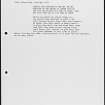Cruden Bay, Old Parish Church Of St Olaf And Churchyard
Burial Ground (Medieval), Church (Medieval), Churchyard (Medieval), Commemorative Stone (Period Unknown), Font (Period Unassigned)
Site Name Cruden Bay, Old Parish Church Of St Olaf And Churchyard
Classification Burial Ground (Medieval), Church (Medieval), Churchyard (Medieval), Commemorative Stone (Period Unknown), Font (Period Unassigned)
Alternative Name(s) St Olaus's Chapel; St Olave's Church
Canmore ID 20865
Site Number NK03NE 1
NGR NK 08852 36308
NGR Description NK 08852 36308 and NK 0875 3625
Datum OSGB36 - NGR
Permalink http://canmore.org.uk/site/20865
- Council Aberdeenshire
- Parish Cruden
- Former Region Grampian
- Former District Banff And Buchan
- Former County Aberdeenshire
NK03NE 1 08852 36308 and 0875 3625
(NK 0885 3630) Human Remains found here. AD 1857 (NAT).
(NK 0875 3625) Site of Grave (NAT).
OS 6" map, Aberdeenshire, 2nd ed., (1901).
(NK 0885 3630) St Olaus's Chapel (NR) (Site of).
OS 6" map, (1959).
For present parish church (NK 0705 3657), see NK03NE 20.
The site of the former church of Cruden parish, abandoned because of sand encroachment. There is no record or tradition of its removal to the present site (NK03NE 20), but Eeles suggests that the translation took place about the middle of the 13th century, roughly 200 years after its foundation and dedication to St Olave. A portion of the east wall and the foundation of the other walls survived until about 1837 when they are said to have been quarried for road metalling. Excavation of the church by Maj-General Moore in 1857 confirmed that it had been overwhelmed by sand, and also exposed many graves in the surrounding burial ground. C.100 yds W of the church, a few stones mark the site of a grave where traditionally a Danish Chieftain was buried after the battle (NK03NE 13). A large blue marble slab which formerly marked this grave, was removed to the parish churchyard c.1748. It is inscriptionless, but its surface indicates that it appears to have been enriched with monumental brasses. An extremely rough font which Eeles deduces to be pre-13th century probably came from this site and after being used by the episcopal congregation (during which time it appears to have been touched up), it was sunk into the garden of St James's Rectory (NK 072 356).
O S Name Book 1868; J B Pratt 1862; F C Eeles 1913.
There is no trace of the church or grave, and no knowledge of the font at the house formerly St James's Rectory.
Visited by OS (RL) 18 May 1972.




















